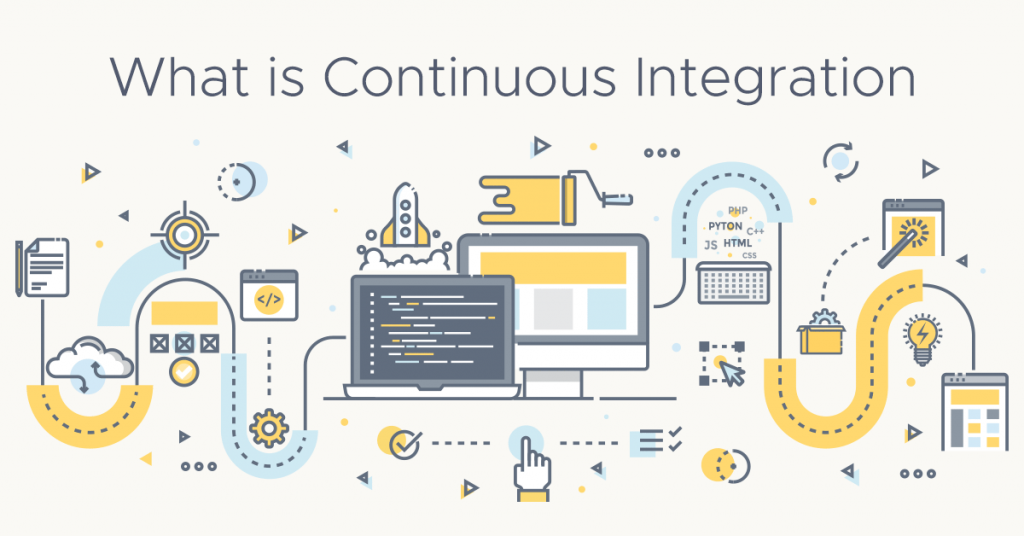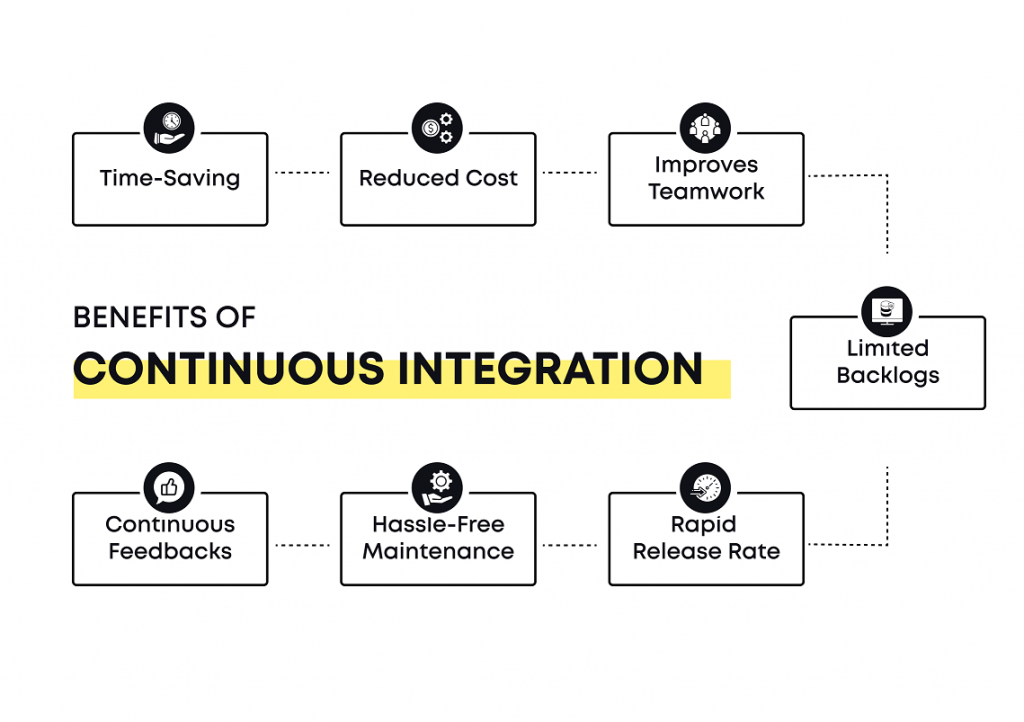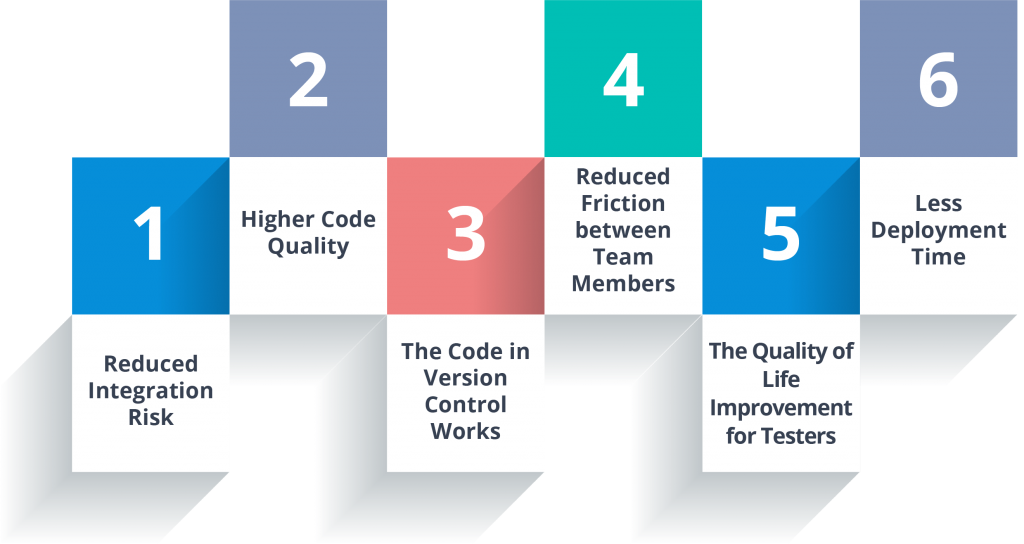
Continuous Integration (CI) is a software development practice and approach that involves the frequent and automated integration of code changes from multiple developers into a shared repository. The primary goal of Continuous Integration is to detect and address integration issues early in the development process, ensuring that changes do not break the existing codebase and that the software remains in working position at all times.
Key principles and practices of Continuous Integration include:
- Frequent Code Integration: Developers frequently commit their code changes to a version control system (e.g., Git), often several times a day.
- Automated Builds: Automated build processes compile, build, and package the application using the latest code changes, ensuring that the application can be consistently built without manual intervention.
- Automated Testing: Comprehensive automated tests, including unit tests, integration tests, and other types of tests, are run automatically to validate the correctness and functionality of the code.
- Immediate Feedback: Developers receive immediate feedback on the status of their code changes, including test results and potential issues, facilitating quick resolution.
- Version Control: All code changes are tracked in a version control system, allowing developers to easily review, revert, or collaborate on changes.
- Isolation of Changes: CI environments often create isolated, disposable environments for each code change to prevent conflicts and ensure that changes are tested in isolation.
- Parallel Testing: CI pipelines may parallelize tests to speed up the feedback loop, enabling faster development and testing cycles.
Why We Need Continuous Integration?
- Early Issue Detection: CI helps detect integration issues, bugs, and conflicts early in the development process when they are easier and less costly to fix. This reduces the risk of issues accumulating and becoming complex to resolve.
- Code Quality: Automated tests in CI pipelines ensure that code changes meet quality and functionality requirements, leading to higher overall code quality.
- Efficient Collaboration: CI encourages collaborative development, allowing multiple developers to work on different parts of the codebase simultaneously. Frequent integration helps teams stay in sync.
- Reduced Integration Risks: CI reduces the risk of integration problems by continuously merging code changes, which leads to smaller and more manageable integration efforts.
- Consistency: CI ensures that the application can be consistently built and tested, regardless of the developer or environment, fostering a reliable development process.
- Faster Development Cycles: With CI, developers receive quick feedback on their changes, allowing them to iterate and make improvements more rapidly, resulting in faster development cycles.
- Increased Confidence: Developers and teams have greater confidence in their code changes because they are validated through automated testing and integration.
- Enhanced Productivity: CI automates repetitive tasks, such as building and testing, freeing developers to focus on writing code and adding value.
- Lower Maintenance Costs: Detecting and addressing issues early reduces the long-term maintenance and support costs of the software.
- Continuous Deployment Readiness: CI sets the foundation for Continuous Deployment (CD), where code changes can be automatically and safely deployed to production when they pass all tests. This enables rapid delivery to end-users.
- Improved Code Review: CI makes code reviews more effective by providing automated test results and ensuring that the code is ready for integration.
- Scalability: CI can easily scale to accommodate larger development teams and complex codebases, ensuring that the development process remains efficient.
Continuous Integration is essential because it promotes early issue detection, code quality, collaboration, and efficiency in software development. It reduces integration risks, enhances code consistency, and contributes to faster development cycles, ultimately leading to higher-quality software products delivered more reliably and efficiently.
What is the Advantage of Continuous Integration?

- Early Issue Detection: CI helps detect integration issues, bugs, and conflicts early in the development process when they are easier and less costly to fix. This reduces the risk of issues accumulating and becoming complex to resolve.
- Improved Code Quality: Automated tests in CI pipelines ensure that code changes meet quality and functionality requirements, leading to higher overall code quality.
- Efficient Collaboration: CI encourages collaborative development, allowing multiple developers to work on different parts of the codebase simultaneously. Frequent integration helps teams stay in sync.
- Reduced Integration Risks: CI reduces the risk of integration problems by continuously merging code changes, which leads to smaller and more manageable integration efforts.
- Consistency: CI ensures that the application can be consistently built and tested, regardless of the developer or environment, fostering a reliable development process.
- Faster Development Cycles: With CI, developers receive quick feedback on their changes, allowing them to iterate and make improvements more rapidly, resulting in faster development cycles.
- Increased Confidence: Developers and teams have greater confidence in their code changes because they are validated through automated testing and integration.
- Enhanced Productivity: CI automates repetitive tasks, such as building and testing, freeing developers to focus on writing code and adding value.
- Lower Maintenance Costs: Detecting and addressing issues early reduces the long-term maintenance and support costs of the software.
- Continuous Deployment Readiness: CI sets the foundation for Continuous Deployment (CD), where code changes can be automatically and safely deployed to production when they pass all tests. This enables rapid delivery to end-users.
- Improved Code Review: CI makes code reviews more effective by providing automated test results and ensuring that the code is ready for integration.
- Scalability: CI can easily scale to accommodate larger development teams and complex codebases, ensuring that the development process remains efficient.
What is the feature of Continuous Integration?

- Automated Builds: The process of compiling and building the application code is automated to ensure consistency and repeatability.
- Automated Testing: Comprehensive automated testing, including unit tests, integration tests, and other types of tests, is run automatically to validate the correctness and functionality of the code.
- Continuous Integration (CI) Server: CI pipelines are managed by a CI server, which monitors the version control system for code changes and triggers automated builds and tests.
- Version Control Integration: CI is tightly integrated with version control systems (e.g., Git), ensuring that code changes are tracked, managed, and integrated into the codebase.
- Isolation of Changes: CI environments often create isolated, disposable environments for each code change to prevent conflicts and ensure that changes are tested in isolation.
- Parallel Testing: CI pipelines may parallelize tests to speed up the feedback loop, enabling faster development and testing cycles.
- Feedback and Notifications: CI provides immediate feedback to developers, notifying them of build and test results, ensuring quick identification and resolution of issues.
- Logging and Reporting: CI systems generate logs and reports, providing visibility into the build and test processes and facilitating troubleshooting.
- Customizable Pipelines: CI pipelines can be customized to fit the specific needs of a project, including the choice of build tools, testing frameworks, and deployment targets.
- Integration with Deployment: CI pipelines can integrate with deployment tools and processes to automate the release of code changes to various environments.
Continuous Integration offers numerous advantages, including early issue detection, improved code quality, efficient collaboration, and enhanced productivity. Its key features include automated builds and testing, continuous integration server, version control integration, and the ability to isolate changes for testing.
What is the Top 10 Use cases of Continuous Integration?
Continuous Integration (CI) is a software development practice where code changes are frequently merged into a central repository, where they are automatically built and tested. This helps to ensure that code changes are compatible with each other and that the overall quality of the software is maintained.
Here are the top 10 use cases of Continuous Integration:
- Increased speed. CI can help to increase the speed of software delivery by automating the process of building and testing code.
- Improved quality. CI can help to improve the quality of software by automating the testing process and by detecting bugs early on.
- Reduced costs. CI can help to reduce the costs of software delivery by automating the process and by reducing the need for manual intervention.
- Improved reliability. CI can help to improve the reliability of software by detecting bugs early on and by automating the deployment process.
- Improved security. CI can help to improve the security of software by automating the testing process and by deploying code more frequently.
- Improved compliance. CI can help organizations to comply with regulations by automating the testing process and by deploying code more frequently.
- Improved customer satisfaction. CI can help to improve the customer satisfaction by delivering software more frequently and by fixing bugs more quickly.
- Improved employee satisfaction. CI can help to improve the employee satisfaction by automating the process and by reducing the stress of manual intervention.
- Improved innovation. CI can help organizations to innovate more effectively by automating the process and by freeing up engineers to focus on new features and projects.
- Increased visibility. CI can help organizations to increase visibility into the software development process by collecting and analyzing data. This can help them to recognize and solve issues early on.
How to Implement Continuous Integration?
The way to implement Continuous Integration depends on the specific needs of the organization. However, some common steps include:
- Establish a CI team. CI should be implemented by a team that includes representatives from development, operations, and quality assurance.
- Define the goals of CI. The team should define the goals of CI, such as increasing speed, improving quality, or reducing costs.
- Identify the tools and technologies needed. The team should identify the tools and technologies needed to implement CI.
- Develop a plan for implementation. The team should develop a plan for implementing CI. This plan should include timelines, specific goals, and responsibilities.
- Implement the plan. The team should implement the plan for CI.
- Monitor and improve. The team should monitor the implementation of CI and make improvements as needed.
Continuous Integration is a composite undertaking, but it can be a very prizing one. By implementing Continuous Integration, organizations can improve the speed, quality, reliability, security, compliance, customer satisfaction, employee satisfaction, innovation, and visibility of their software development process.
Some additional considerations for implementing Continuous Integration:
- You need to have a strong understanding of your organization’s needs.
- You need to have the support of the organization’s leadership.
- You need to be willing to invest in the right tools and technologies.
How to Get certified in Continuous Integration?
- DevOpsSchool.com
- scmGalaxy.com
- BestDevOps.com
- Cotocus.com

There are no Continuous Integration (CI)-specific certification exams available yet. However, there are a number of certifications that can help you learn the fundamentals of CI, such as:
- Google Cloud Certified – Professional Cloud DevOps Engineer. This certification is offered by Google Cloud and covers the skills and knowledge needed to design, deploy, and manage cloud solutions.
- AWS Certified DevOps Engineer – Professional. This certification is offered by Amazon Web Services and covers the skills and knowledge needed to design, deploy, and operate cloud-based applications.
- Microsoft Certified Azure DevOps Engineer Expert. This certification is provided by Microsoft and covers the skills and knowledge needed to design, operate, and deploy cloud-based applications.
In addition to certifications, there are a number of other resources that can help you learn CI, such as:
- Books. There are a number of books available on CI. These resources can help you learn about the concepts and practices of CI.
- Articles. There are a number of articles available on CI. These resources can help you learn about the latest trends in CI.
- Online courses. There are a number of online courses available on CI. These courses can teach you the fundamentals of CI and help you prepare for the certification exam.
- Workshops. There are a number of workshops available on CI. These workshops can help you learn about the latest trends in CI and get hands-on experience with the tools and technologies.
- Conferences. There are a number of conferences that cover CI. These conferences can be a great way to learn about CI from experts and network with other CI professionals.
How to Learn Continuous Integration?

The best way to learn CI is to use a combination of these resources. Start by understanding the fundamentals of Cloud computing and DevOps. Then, focus on learning about the specific CI practices and technologies that are relevant to your organization.
Here are some additional tips for learning CI:
- Get involved in the CI community. There is a growing community of CI professionals who are active on social media and in online forums. Get involved in this community to learn from others and stay up-to-date on the latest CI trends.
- Attend conferences and workshops. Attending conferences and workshops is a great way to learn about CI from experts.
- Get hands-on experience. The best way to learn CI is to get hands-on experience with it. You can do this by setting up a CI environment in the cloud or by working on a CI project at your job.
Continuous Integration is a rapidly growing field, and there is a high demand for CI professionals. By learning CI, you can position yourself for a successful career in this field.
Some specific resources that you can use to learn CI:
- The CI/CD Pipeline by Martin Fowler. This book provides a comprehensive overview of the CI/CD pipeline, from source control to deployment.
- Continuous Integration: A Practical Guide by James Shore. This book provides a practical guide to implementing CI, with real-world examples.
- Continuous Delivery: Reliable Software Releases through Build, Test, and Deployment Automation by Jez Humble and David Farley. This book provides a comprehensive overview of continuous delivery, including CI.
- The DevOps Handbook: How to Create Continuous Delivery in the Enterprise by Gene Kim, Kevin Behr, George Spafford, and Andrew Ward. This book provides a comprehensive overview of DevOps, including CI.
- Accelerate: Building and Scaling High Performing Technology Organizations by Gene Kim, Jez Humble, Patrick Debois, and John Willis. This book provides a comprehensive overview of how to build and scale high-performing technology organizations, including CI.
- Degree Pursuit: Navigating the Path to Educational Excellence - July 4, 2024
- Why Is Studying English Important in a Business Environment? - July 4, 2024
- Top 10 Data Science Skills You Need in 2024 - July 3, 2024

